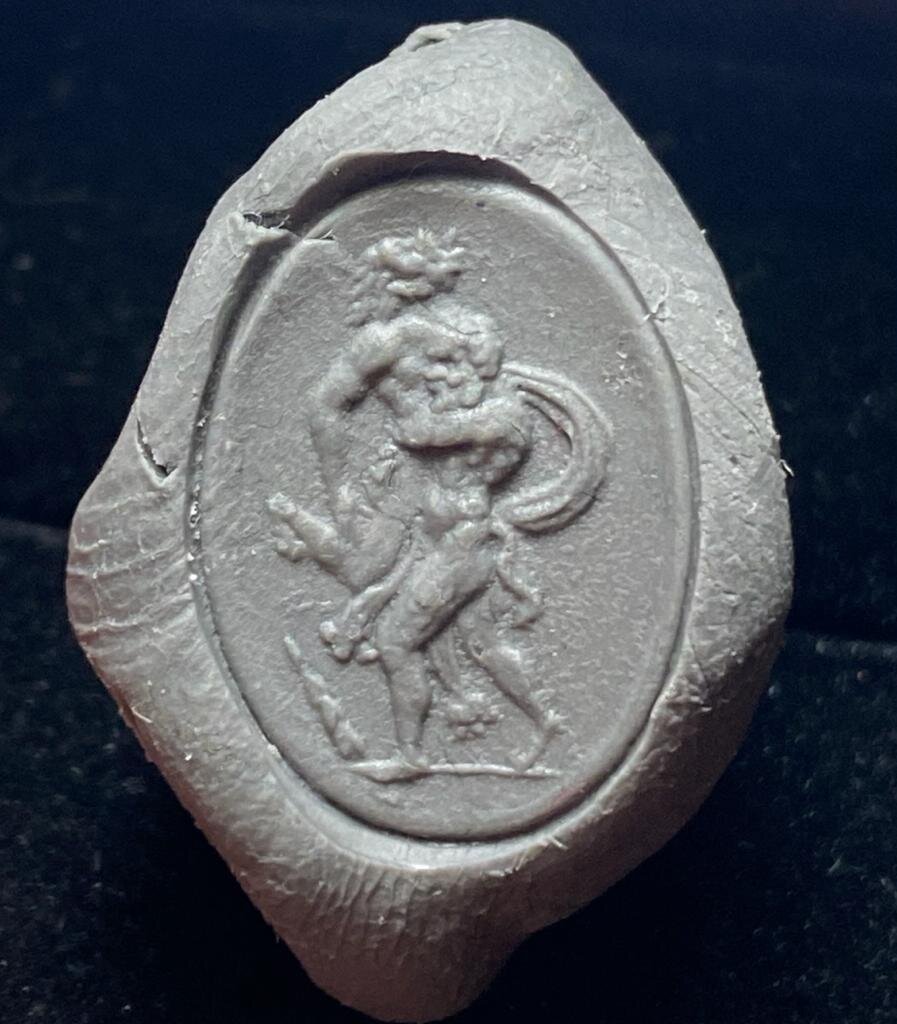A Marlborough/Arundel "Royal" gem ring
An extremely fine and rare 16th century enamelled gold and lapis lazuli intaglio ring with a most desirable provenance
The lapis lazuli intaglio of Hercules wrestling with Antaeus; Hercules with billowing cloak and lionskin, his club on the ground before him, with ground line. Very finely carved, the bezel and shank with multi-coloured enamel scroll decoration, two fleur-de-lys in white enamel to the underside
The gem is described in the Boardman/Wagner/Zwierlein-Diehl catalogue as renaissance, but had previously always been referred to as Roman
Second half of the 16th century
The head 16 x 14mm, 5.8g gross. Finger size UK - Q, US - 8, Fr - 57 3/4
Arundel A56 (2), Marlborough 301, Boardman/Wagner/Zwierlein-Diehl catalogue of the Marlborough collection No 171
Mentioned in “Rings for the Finger” by George Frederick Kunz, who quotes Rev.C.W.King’s conjecture that from the style of ornamentation the ring may have belonged to one of the Valois Kings of France
Kunz, George Frederick, 1856-1932 Rings for the finger : from the earliest known times to the present, with full descriptions of the origin, early making, materials, the archaeology, history, for affection, for love, for engagement, for wedding, commemorative, mourning, etc.
“The rich Arundel Collection, chiefly brought together by a Lord Howard of Arundel, towards the end of the seventeenth century, incorporated in the Marlborough Cabinet and later dispersed, included a beautifully adorned gold ring set with a splendid lapis lazuli on which a Roman engraver had cut the design of Hercules wrestling with Antaeus. The hoop of this ring is ornamented on the inside with two fleur-de-lys in white enamel, the entire ring being covered with arabesques of entwined vine branches in black enamel. In his description. Rev. C. W. King conjectures from the style of ornamentation that the ring may have belonged to one of the Valois kings of France.”
For similar designs in enamel it is interesting to note several jewels illustrated in the Jewel Book of Duchess Anna of Bavaria which was produced in 1552
PROVENANCE;
Thomas Howard (1586-1646), 14th Earl of Arundel.
Entry in the 18th century catalogue of the Arundel gems by Andrew Fountaine:
56 – Hercules, crushing or squeezing Antaeus, raised from the ground against his breast: very fine. Lapis lazuli. – Antaeus was a giant and famous wrestler, who recovered his strength as soon as his feet touched the ground. Hercules, making this discovery, caught him in his arms, and raising him from the ground, he crushed him in such a manner as to overcome him. This was one of the twelve labours of Hercules – one of the best ancient statues represents this action. Pliny mentions the statue.
Inherited by his wife Alatheia Talbot (1585-1654) then by descent until gifted in 1762 on the occasion of the marriage of Lord Charles Spencer, by whom given to his elder brother George Spencer (1739-1817), 4th Duke of Marlborough.
David Bromilow, Bitteswell Hall, Lutterworth, until 1898;
by descent to Julia Harriet Mary Jary (née Bromilow);
Christie, Manson and Woods London, Catalogue of the Marlborough Gems: Being a Collection of Works in Cameo and Intaglio Formed by George, 3rd Duke of Marlborough, 27 June 1899, lot 301. Sold to Asher Wertheimer (1844-1918) for 42 Guineas
POA

A Marlborough/Arundel "Royal" gem ring








